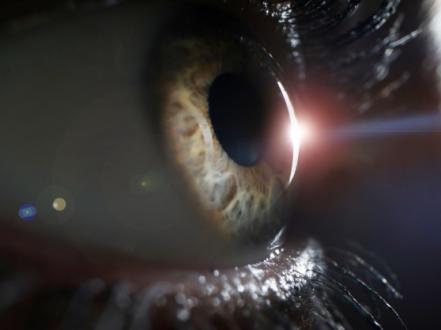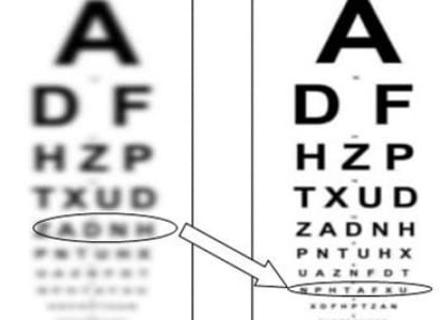Often in publications about artificial lenses that correct presbyopia (multifocal, trifocal, or EDOF) many authors write about near or intermediate vision. Let's find out what it is.
The optical system of the eye is designed so that a healthy human eye (without refractive errors) in a relaxed state of accommodation forms a clear image of objects at a distance of about 2 meters. To view objects that are closer than this distance, a certain level of eye accommodation tension is required. The closer the object is, the more accommodation is strained.
When a person develops presbyopia or cataract, the question about restoring quality vision arises. And a person should have good quality of distance and near vision.
Approximately this division by distance of vision exists in ophthalmology:
Approximately this division by distance of vision exists in ophthalmology:
- distance vision: everything far than 2 m, to infinity;
- intermediate vision: this is a distance of about 60-100 cm from the eye;
- near vision: this is a distance of approximately 35-50cm.
You can read about how to get excellent intermediate and near vision without glasses when you have presbyopia or cataracts in the following publications.
What is the intermediate distance in vision?
Imagine a scenario where you're comfortably seated at your desk, sifting through paperwork, or perhaps engrossed in the movement of pixels on your computer screen. That spot, around 60-100 cm from your eyes, is the intermediate zone.
The intermediate visual capacity is pivotal for our daily activities, bridging the gap between near and far effortlessly. Consider the times you've found yourself immersed in a gripping novel, with the pages resting comfortably at arm's length. That's where your intermediate visual capacity is actively engaged, enabling seamless exploration of pages without disruption.
Now, let's bring cataracts into the spotlight. As our eyes encounter the challenges of aging or other factors, the crystal-clear lens may find itself clouded by cataracts. This visual nemesis doesn't discriminate – it can stealthily encroach upon your intermediate visual ability, making the words on that page or the characters on your screen blur into an indistinct haze.
Do not be alarmed, as the field of ophthalmology has developed innovative solutions. Artificial lenses, marvels of modern science, can step in to restore the functions of your intermediate viewing ability. Whether you're deciphering spreadsheets, indulging in your favorite hobbies, or simply enjoying the clarity of a computer screen, these lenses aim to bring back vibrancy to your vision.
Now, let’s unravel near and distance spots, exploring vision nuances. There is no better time to gain more insights into the captivating world of vision, where science and clarity converge.
What is normal vision near and far points?
Delving into the intricacies of visual acuity, we turn our attention to the concept of near and far points in the context of normal vision. Defined by specific distances from the eye, these points serve as essential metrics in understanding the capabilities of our ocular system.
The near point, typically situated around 35-50 cm from the eyes, denotes the closest distance at which the eye can focus sharply. This proximity is paramount for tasks requiring detailed visual scrutiny, such as reading or examining objects at close range. The far point, conversely, represents the maximum distance at which the eye can discern objects with clarity. In normal circumstances, this point extends beyond 2 meters, encompassing the vast majority of daily observations of distant objects. But in fact, the distant focal point of sight for a typical eye is acknowledged to be at an infinite distance, indicating the absence of a particular range. In practical terms, this denotes the juncture at which parallel beams of light entering the eye converge on the retina while the eye is in a state of ease.
In scientific inquiry, the normal vision of near and far points serves as foundational parameters. The near point is vital for assessing the eye's accommodative capabilities, revealing its ability to adjust focus for proximal tasks. Meanwhile, the far point elucidates the eye's capacity for sharp focus on remote elements, essential for activities ranging from navigating the environment to appreciating expansive vistas.
It is crucial to recognize that deviations from these normative measurements may occur due to factors such as presbyopia and cataracts. These ocular conditions can introduce shifts in both the near and far points, impacting the eye's ability to maintain optimal focus at varying distances. Luckily, there are strategies for managing and mitigating such visual challenges that are created based on the scientific underpinnings and clinical considerations associated with these deviations.
What is the distance between intermediate and near vision?
The space between intermediate and near visual capacity unfolds as a critical chapter in the story of ocular capabilities. Scientifically defined, this distance spans approximately 35-100 cm, encapsulating the range where our eyes adeptly transition from near-focused tasks to those requiring an intermediate gaze.
Consider a scenario where you're immersed in a captivating read, the book comfortably held about 35 cm from your eyes. Now, envision seamlessly shifting your attention to a computer screen situated around an arm's length away, engrossed in the details of your work. This is the dynamic realm of intermediate vision, where our eyes gracefully adapt to the demands of varying distances.
In these functions of vision, the eyes exhibit remarkable flexibility. Whether perusing documents, engaging in hobbies, or simply navigating daily tasks, our vision seamlessly adjusts to the nuances of the environment.
As we conclude our exploration of the multifaceted dimensions of vision, from the farthest horizons to the closest details, we've unraveled the secrets of normal vision, examined the impact of conditions like presbyopia and cataracts, and appreciated the nuanced distances our eyes effortlessly traverse. May this exploration of vision's landscapes provide a profound understanding of its intricacies.
As we conclude our exploration of the multifaceted dimensions of vision, from the farthest horizons to the closest details, we've unraveled the secrets of normal vision, examined the impact of conditions like presbyopia and cataracts, and appreciated the nuanced distances our eyes effortlessly traverse. May this exploration of vision's landscapes provide a profound understanding of its intricacies.






